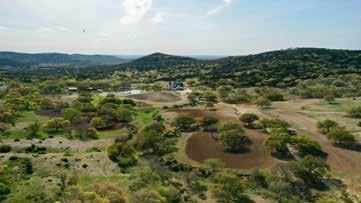
10 minute read
Conservation Legacy
Progress of Conservation Legacy “2.0”
Article and photos courtesy of CONSERVATION LEGACY STAFF
The first installment of funding from the Elma Dill Russell Spencer Foundation arrived in 2021, allowing Conservation Legacy (CL) to put into action Year One of a five-year plan. The plan includes program expansion, new program development, and system improvements that will raise CL to a new level of natural resource education excellence.
Year One included more than a dozen new goals, programs, and projects, which currently range in evolvement from “in development” to “complete.” Presented here are four projects that highlight the expansion, development, and improvements underway in Conservation Legacy.
FAMILY LAND, WATER & WILDLIFE EXPEDITIONS - MENTOR TRAINING
TWA hosted its first mentor training for the new conservation program, Land, Water & Wildlife Expeditions (LWWE) April 30 and May 1. Nine participants became certified program mentors through this pilot workshop.
Over the course of the two-day training, participants learned how to plan, recruit, and coordinate for a one- to three-day outdoor experience on private land. They also heard from experts about resources that can be incorporated into LWWE programming.
New mentors explored strategies for team building and group facilitation, the use of GIS applications, interpretive practices, and the use of citizen science applications such as eBird, Merlin Bird ID, and iNaturalist on private land.
Congratulations to the first cohort of mentors. CL is excited to see the impact they will make with families across the state.
STUDENT LAND, WATER & WILDLIFE EXPEDITIONS
Land, Water, and Wildlife Expeditions are part of Texas Wildlife Association’s educational outreach program which strives to facilitate natural resource literacy within middle and high schools. It does this by creating tangible relationships between the outdoors and essential academic skills.
Whether conducting an activity at school or on a private ranch nearby, students have a unique opportunity to observe, touch, smell, and feel what they are studying and increase or spark a passion to become good land stewards. Students will also get the chance to visit with local professional partners in various natural resource fields who serve as instructors and mentors.
TWA works with school districts and natural resource partners across the state to get students outside. Several campuses across the state have been selected to immerse students in land, water, and wildlife conservation. Programs launching this fall will include learning objectives aligned with the updated state TEKS and the mission of TWA.
These Expedition programs were created with the Texas teacher in mind, assisting them to meet state-mandated objectives, focusing on shared conservation topics all while fostering a greater appreciation of the natural world.

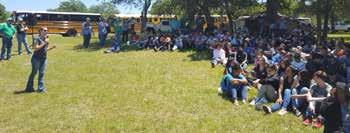
GRAZING MATTERS
In July 2019, TWA hosted a daylong conference titled, “Grazing Matters: Soil Health, Habitat and Wildlife.” That conference sparked ideas for a new web-based networking tool, one which would provide a platform for landowners and producers to not only discuss information about restorative grazing, but also to build relationships that could lead to new grazing leases.
Thanks to support from the Dixon Water Foundation and other partners, TWA has been working to make those ideas a reality. The tool—a website titled “Grazing Matters”—is under development and promises the following features: • An easy-to-use interactive map showing potential partners across the state • The ability for users to create a profile as either a producer or a landowner • Landowner stories—testimonials from real landowners who are doing restorative grazing work • Information about restorative grazing practices, including the economic and ecological benefits of restorative grazing • Information on cost shares and other support programs
The framework and key features of the website are already in place, and developers are currently working on improving its aesthetics and usability. Look for more information here and on the Grazing Matters program page as the full launch of the site approaches.
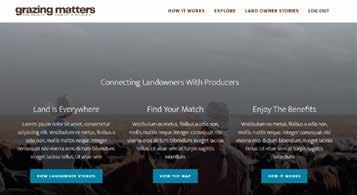
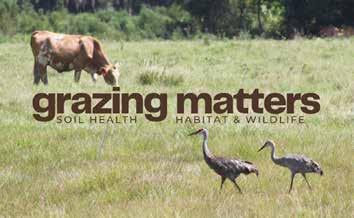
NEW WEBSITE AND CRM (CUSTOMER RELATIONSHIP MANAGEMENT) DATABASE
Starting in April, TWA began work on a project to develop a new website and database that will allow the organization to provide enhanced customer service to our members, strengthen internal business practices, and improve impact reporting.
Conservation Legacy components of the new website and system, to be launched in phases: • Rebuilt Discovery Trunk reservation system • New Curriculum Portal providing online access to all
CL lessons • New classroom presentation reservation system • New volunteer management and training portal • Improved systems of program participation tracking— i.e., a participant’s lifetime participation profile, or identifying inaccurate webinar registrations

CONFERENCES MAKING A COMEBACK Photo courtesy of Dr. Louis Harveson
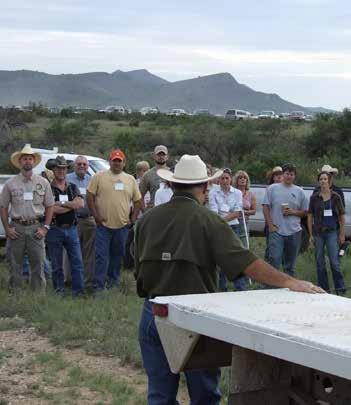
After a multi-year hiatus due to COVID, the Trans-Pecos Wildlife Conference and the South Texas Wildlife Conference, hosted by TWA and partners, are returning in 2022.
Here’s what you need to know:
TRANS-PECOS WILDLIFE CONFERENCE
This event, last held in 2016 and co-hosted by the Borderlands Research Institute (BRI), Texas Parks and Wildlife Department (TPWD), and TWA, will be held August 4-5. It focuses on the unique challenges and opportunities characteristic of land stewardship in West Texas. The first day will take place in Alpine at Sul Ross State University’s Morgan University Center and will cover topics on both game and non-game species of interest, as well as landowner support programs for habitat restoration activities. A half-day field trip on August 5 will give participants an opportunity to see examples of land stewardship practices in action (location TBD).
The cost to attend is $75 for early registration (before July 25) and $100 for late registration (July 25 and later, including at the door). Register today at bit.ly/tpwc2022
SOUTH TEXAS WILDLIFE CONFERENCE
Traditionally, this conference is held bi-annually, but it is returning in-person for the first time in four years. The conference, “Changing Paradigms in Wildlife Management,” is co-hosted with our partners, the Caesar Kleberg Wildlife Research Institute (CKWRI), and TPWD. During the day-long event, speakers will explore the effects of past, present, and (potential) future management actions in South Texas.
Join us Friday, September 9 in Cuero at the Municipal Park Clubhouse to attend. A detailed agenda can be found at the link below.
Registration is $80 (before August 30) and $100 (after August 30, including at the door). Sign up at bit.ly/stwc2022
Trans-Pecos Wildlife Conference 2022

WILDLIFE MANAGEMENT IN THE TRANS PECOS
Sul Ross State University - August 4-5, 2022
JOIN TODAY
NONGAME/TOURISM
• GRASSLAND BIRDS AND
SHRUB ENCROACHMENT • LIVING WITH BLACK BEARS • BIRDING THE BORDER:
AN ECOTOURISM INITIATIVE • RAPTOR RESEARCH • AUDUBON’S BIRD
FRIENDLY BEEF
HABITAT
• CONSERVATION PLANNING/
ENERGY DEVELOPMENT • GRAZING AND PRONGHORN • LANDOWNER INCENTIVES FOR
HABITAT RESTORATION (NFWF, TPWD LIP, Partners,
SWCDs, RGJV, BRI, WTNS, BCR
BIG GAME
• AOUDADS IN WEST TEXAS:
FRIEND OR FOE? • ANTLER DEVELOPMENT • PRONGHORN STATUS REPORT
AND RESTORATION UPDATE • CWD UPDATE
Register Online:
TAKE A KID HUNTING TODAY!
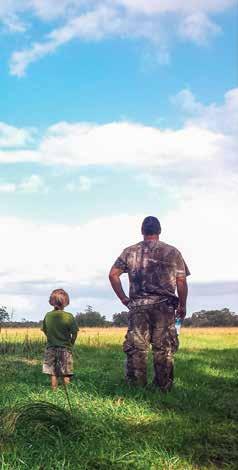

TEXAS A&M UNIVERSITY
Blue-Green Algae
Visual Indicators and Management
Article by BRITTANY CHESSER, Aquatic Vegetation Management Program Specialist, Texas A&M AgriLife Extension Service TODD SINK, Associate Professor and Aquaculture Extension Specialist, Texas A&M AgriLife Extension Service Photos courtesy of TAMU AGRILIFE EXTENSION SERVICE
Harmful algal blooms have been a hot topic over the past few years, particularly blooms dealing with species that release natural acute or chronic toxins under certain conditions, such as cyanobacteria, which is also commonly referred to as blue-green algae. These toxins potentially cause a health threat to fish, livestock, pets, and humans that contact or ingest water containing them.
The common name “blue-green algae” is a little misleading when characterizing the hundreds of known cyanobacteria species, since they are photosynthetic bacteria with many different growth forms and colorations. Notably, cyanobacteria blooms are not always “blue-green” but can range from brown and rust-red to

Blue-green algae is not accurately named, not completely at least. In addition to shades of blue and green, the cyanobacteria can range from brown and rust-red to turquoise blue to brilliant green. This is due to protein complexes that produce various pigmentations in their cells. One of the first indications of a toxic blue-green algae bloom are dead and dying aquatic life. Toxic blooms can also be a health threat to wildlife, livestock and even people.
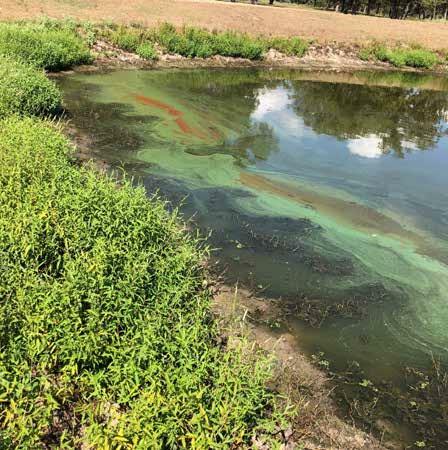
turquoise blue to brilliant green. This is due to protein complexes that produce various pigmentations in their cells.
Some cyanobacteria species are microscopic, mixed evenly throughout the water column, and do not present visual cues to their presence. Other more visible cyanobacteria species can be found floating around the shoreline in various growth forms,
largely characterized by their appearance as “spilled oil paint” on water, surface scums, globules, or floating mats.
While cyanobacteria are present in nearly every water body, they are not always undergoing bloom conditions or producing and releasing toxins. Toxin production and release is mainly used as a defense mechanism in response to grazing or nutrient competition during summer months when water temperatures, algal growth and competition are at their highest with little rain or wind.
Visual cues, as described above, such as surface scums or a spilled paint appearance found in downwind areas along banks are evidence of a bloom and a strong indication that a cyanobacteria are actively producing toxins. These blooms may be accompanied by dead or dying aquatic life such as fish, turtles, and frogs.
If a bloom is suspected, treat it immediately with an algaecide containing a copper-based product (copper sulfate or chelated copper complexes) or sodium carbonate peroxyhydrate to lyse the algal cells. Cyanobacteria will begin to release toxins as they die, potentially worsening any existing fish or wildlife kill, so it is very important to treat the bloom slowly in sections. Treat no more than 10% to 15% of the pond area at a time and wait 10-14 days between each subsequent treatment.
If a fish kill is occurring or is worsened by the algaecide treatment, add 2 parts per million of potassium permanganate to the pond to neutralize the cyanotoxins. Also, when possible: 1) restrict access by livestock, pets, and humans; 2) add supplemental aeration; 3) flush with fresh water; and 4) stop feeding and harvesting fish.
Other types of management including skimming, dilution, pond dyes and others are also options but the level of control will vary due to cyanobacteria species and pond logistics.
The best type of management is prevention. Limiting phosphorus runoff from fertilizer, animal waste, septic systems, etc. can reduce the chances of experiencing bloom conditions. Too much phosphorous in a water body causes a nitrogen imbalance which creates a competitive advantage for cyanobacteria because they can fix atmospheric nitrogen to outcompete other species.
To confirm that cyanobacteria are the cause of death for livestock or wildlife, a necropsy is recommended over a water sample. Toxins can be detected from a water sample but do not always lead to a definitive answer. For more information on testing, see: “Texas A&M AgriLife Aquaculture Specialist Addresses Algae-related Dog Deaths” (https://agrilifetoday. tamu.edu/2019/08/16/texas-am-agrilife-aquaculture-specialistaddresses-algae-related-dog-deaths-cyanobacteria/ )
For more photos, key characteristics, and management recommendations please see: https://aquaplant.tamu.edu/bluegreen-algae/
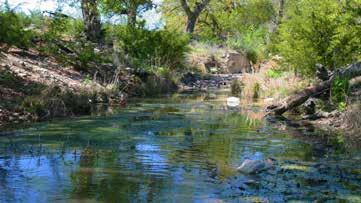
RANCHO EL MIRASOL 6,570+ Ac. Edwards-Val Verde County
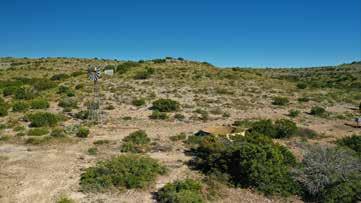
PRISTINE VALLEY RANCH 790+ Ac. Bandera County HIDDEN SPRING RANCH 3,439+ Ac. Mason County
